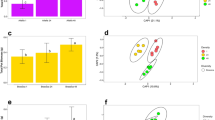Summary
To investigate the influence of soil-borne pathogens on the population biology of a grassland species in natural vegetation, soil samples were collected, partly disinfected or sterilized and then planted with Plantago lanceolata. Those on some of the untreated soils showed growth reduction due to a biotic factor in the soil. This growth reduction was not associated with the density of P. lanceolata plants at the sampling sites. It was only visible when differences in abiotic factors — especially nutrient levels —were eliminated. In the natural situation the nutritional status of the soil has a far greater impact than biotic soil factors. Micro-organisms harmful to Plantago roots are considered to be of minor importance in the distribution of the individuals in the P. lanceolata population studied.
Similar content being viewed by others
References
Anderson JPE, Domsch KH (1974) Use of selective inhibitors in the study of respiratory activities and shifts in bacterial and fungal populations in soil. Ann Microbiol 24:189–194
Bertoldi M de, Rambelli A, Giovanetti M, Griselli M (1978) Effects of benomyl and captan on rhizosphere fungi and the growth of Allium cepea. Soil Biol Biochem 10:265–268
Bowen GD, Rovira AD (1976) Microbial colonisation of plant roots. Ann Rev Phytopath 14:121–144
Bremner JM (1965) Inorganic forms of nitrogen. In: Black CA (ed) Methods of soil analysis Part 2. Agronomy 9:1179–1237
Burdon JJ (1982) The effect of fungal pathogens on plant communities. In: Newman EI (ed) The plant community as a working mechanism. Blackwell Scientific, Oxford, pp 99–112
Burdon JJ, Shattock RC (1980) Disease in plant communities. Appl Biol 5:145–219
Campbell R, Newman EI, Lawley RA, Christie P (1982) Relationship between a Rhizoctonia species and grassland plants. Trans Br Mycol Soc 79:123–127
Chapman HD (1965) Chemical factors of the soil as they affect microorganisms. In: Baker KF, Snyder WC (eds) Ecology of soil borne plant pathogens. Univ Calif Press, Berkeley, pp 120–141
Haynes RJ, Goh KM (1978) Ammonium and nitrate nutrition of plants. Biol Rev 53:465–510
Hewitt EJ (1966) Sand and water culture methods used in the study of plant nutrition. CMI Bureau, Bucks, pp 547
Hofer IB, Beck TH, Wallnöfer T (1971) The effect of the fungicide benomyl on the microflora of soil. Z Pflanzenkrankh Pflanzenschütz Bayer 78:399–405
Howard RJ, Morrall RAA (1975) The epidemilogy of leaf spot disease in a native prairy I. The progression of disease with time. Can J Bot 53:1040–1050
Jenkinson DS (1976) The effects of biocidal treatments on metabolism in soil IV. The decomposition of fumigated organisms in soil. Soil Biol Biochem 8:203–208
Newman EI (1978) Root microorganisms: their significance in the ecosystem. Biol Rev 53:511–554
Newman EI, Campbell R, Rovira AD (1977) Experimental alteration of soil microbial populations for studying effects on higher plant interactions. New Phytol 79:107–118
Novozamsky I, Van Eck R, Van Schouwenburg JC, Walinga I (1974) Total nitrogen determination in plant material by means of the indophenol-blue method. Neth J Agric Sci 22:3–5
Olsen SR, Cole CV, Watanabe FS, Dean LA (1954) Estimation of available phosphorus in soils by extraction with sodium bicarbonate. USDA circ 939
Runia WT (1983) Schadegrenzen van Aaterra en Previcur-N. Tuinderij 63:38–39
Salt GA (1979) The increasing interest in ‘minor pathogens’. In: Schippers B, Gams W (eds) Soil-borne plant pathogens. Academic, New York, pp 289–312
Schippers B, Geels FP, Hoekstra O, Lamers JG, Maenhout CAAA, Scholte K (1985) Yield depressions in narrow rotations caused by unknown microbial factors and their suppression by selected Pseudomonads. In: Parker CA, Moore KJ, Wong PTW, Rovira AD, Kollmorgen JF (eds) Ecology and management of soilborne plant pathogens. APS, St Paul
Schippers B, Bakker AW, Bakker PAHM, Weisbeek JM, Lugtenberg B (1986) Plant growth-inhibiting and-stimulating rhizosphere microorganisms. In: Jensen V, Sprensen LH (eds) Microbial communities in soil. FEMS Symposium, Copenhagen, 1985
Scholte K, Kupers LJP (1978) The cause of the lack of self tolerance of winter rye, grown on light sandy soils II. Influences of phytotoxins and soil microflora. Neth J Agric Sci 26:250–266
Shipton PJ (1977) Monoculture and soil-borne plant pathogens. Ann Rev Phytopathol 15:387–407
Skipp RA, Christensen MJ (1982) Invasion of white clover roots by fungi and other soil microorganisms III. The capacity of fungi isolated from white clover roots to invade seedling root tissue. NZ J Agric Res 25:97–102
Smiley RW (1975) Forms of nitrogen and the pH in the root zone and their importance to root infections. In: Bruehl GW (ed) Biology and control of soil-borne pathogens. APS, St Paul, pp 55–62
Troelstra SR, Sluimer L, Smant W, Wagenaar R, Van der Meulen M (1980) On the soil chemistry of natural habitats of Plantago species and Hypochaeris radicata in various parts of The Netherlands in relation to the chemical composition of the plants. Verh Kon Ned Akad Wetensch, Afd Natuurk 2e reeks 77:20–31
Warcup JH (1976) Studies on soil fumigation IV. Effects on fungi. Soil Biol Biochem 8:261–266
Watanabe FS, Olsen SR (1965) Test of an ascorbic acid method for determining phosphorus in water and NaHCO3 extracts from soil. Soil Sci Soc Am Proc 29:677–678
Author information
Authors and Affiliations
Additional information
Study performed by Grassland Species Research Group No 113
Rights and permissions
About this article
Cite this article
de Nooij, M.P., Troelstra, S.R. & Wagenaar, R. Growth reduction in Plantago lanceolata in relation to biotic factors in the soil environment. Oecologia 70, 266–272 (1986). https://doi.org/10.1007/BF00379250
Received:
Issue Date:
DOI: https://doi.org/10.1007/BF00379250




